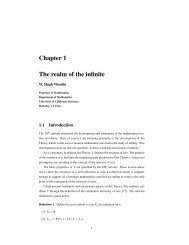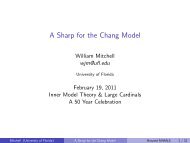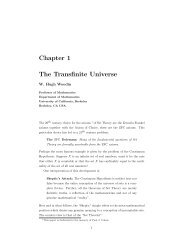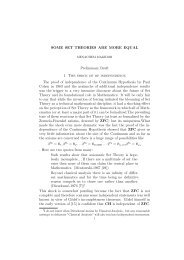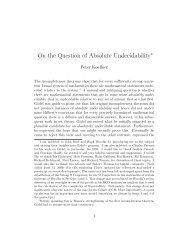The Continuum Hypothesis - Logic at Harvard
The Continuum Hypothesis - Logic at Harvard
The Continuum Hypothesis - Logic at Harvard
You also want an ePaper? Increase the reach of your titles
YUMPU automatically turns print PDFs into web optimized ePapers that Google loves.
4 <strong>The</strong> Multiverse<strong>The</strong> above case for the failure of CH is the strongest known local case foraxioms th<strong>at</strong> settle CH. In this section and the next we will switch sidesand consider the pluralist arguments to the effect th<strong>at</strong> CH does not havean answer (in this section) and to the effect th<strong>at</strong> there is an equally goodcase for CH (in the next section). In the final two section we will investig<strong>at</strong>eoptimistic global scenarios th<strong>at</strong> provide hope of settling the issue.<strong>The</strong> pluralist maintains th<strong>at</strong> the independence results effectively settlethe undecided questions by showing th<strong>at</strong> they have no answer. One wayof providing a found<strong>at</strong>ional framework for such a view is in terms of themultiverse. On this view there is not a single universe of set theory butr<strong>at</strong>heramultiverse oflegitim<strong>at</strong>ecandid<strong>at</strong>es, someofwhich may bepreferableto others for certain purposes but none of which can be said to be the “true”universe. <strong>The</strong> multiverse conception of truth is the view th<strong>at</strong> a st<strong>at</strong>ement ofset theory can only be said to be true simpliciter if it is true in all universesof the multiverse. For the purposes of this discussion we shall say th<strong>at</strong> ast<strong>at</strong>ement is indetermin<strong>at</strong>e according to the multiverse conception if it isneither true nor false according to the multiverse conception. How radicalsuch a view is depends on the breadth of the conception of the multiverse.4.1 Broad Multiverse Views<strong>The</strong> pluralist is generally a non-pluralist about certain domains of m<strong>at</strong>hem<strong>at</strong>ics.For example, a strict finitist might be a non-pluralist about PA buta pluralist about set theory and one might be a non-pluralist about ZFC anda pluralist about large cardinal axioms and st<strong>at</strong>ements like CH.<strong>The</strong>re is a form of radical pluralism which advoc<strong>at</strong>es pluralism concerningall domains of m<strong>at</strong>hem<strong>at</strong>ics. On this view any consistent theory is alegitim<strong>at</strong>e candid<strong>at</strong>e and the corresponding models of such theories are legitim<strong>at</strong>ecandid<strong>at</strong>es for the the domain of m<strong>at</strong>hem<strong>at</strong>ics. Let us call this thebroadest multiverse view. <strong>The</strong>re is a difficulty inarticul<strong>at</strong>ing this view, whichmay be brought out as follows: To begin with, one must pick a backgroundtheory in which to discuss the various models and this leads to a difficult.For example, according to the broad multiverse conception, since PA cannotprove Con(PA) (by the second incompleteness theorem, assuming th<strong>at</strong> PAis consistent) there are models of PA+¬Con(PA) and these models are legitim<strong>at</strong>ecandid<strong>at</strong>es, th<strong>at</strong> is, they are universes within the broad multiverse.20





